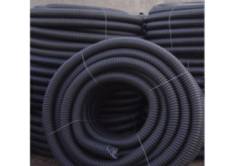From the macroscopic morphology observation and chemical composition analysis results, we know that no metallurgical defects such as slag inclusions, pores, and porosity were found around the corrugated tube cracks; the chemical composition of the corrugated tube complies with the standard requirements. The sensitization temperature range of austenitic stainless steel is 450 ~ 850 ° C. In this temperature range, chromium elements are likely to be enriched near the grain boundaries to form M23C6 type carbides, which causes a chromium-depleted region near the grain boundaries, which makes The corrosion resistance decreases sharply, and intergranular corrosion occurs under the action of corrosive media. Studies have shown that the annealing temperature of Inconel 800 alloy is in the range of 550 ~ 800 ℃. As the annealing temperature increases, the sensitization first increases and then decreases. The working temperature of the failed bellows is about 500 ℃, which is close to the sensitization temperature range. At the same time, the precipitates at the grain boundaries are mainly chromium-rich M23C6 carbides, which is in line with the "chrome-depleted theory".
According to the analysis of crack and fracture morphology, it is known that the occurrence of cracks in the corrugated pipe is the result of the combined effect of intergranular corrosion and stress corrosion, and intergranular corrosion occurs preferentially; the fractures of the corrugated pipe are mainly along the fracture characteristics, and sulfur in the corrosion products of the fracture Higher content. In the petrochemical industry, the polysulfuric acid environment is likely to cause stress corrosion cracking of equipment. Generally, polysulfuric acid is generated by the reaction of sulfuric corrosion products remaining in the equipment with water and oxygen during the shutdown of a plant that processes sulfur-containing crude oil. The stress corrosion cracking caused by polysulfuric acid is characterized by crystal grains, and the working medium of the corrugated pipe contains hydrocarbons, water vapor, and a certain amount of sulfur-containing substances, which provides conditions for the formation of polysulfuric acid. The cause of tube failure is stress corrosion cracking caused by polysulfuric acid. In the polysulfuric acid medium, after chromium accumulates on the grain boundaries to form a chromium-depleted region, the micro-battery formed between the matrix and chromium carbide on the grain boundaries causes the chromium-depleted region to preferentially dissolve, thereby causing intergranular corrosion.
Compared with ordinary pressure vessels, the working conditions of plastic extrusion pc corrugated pipe are more severe. In addition to bearing the working temperature, pressure, and media, it will also cause large deformation. The bellows is deformed to provide the displacement required for the compensation of the pipe. The displacement causes the bellows to generate higher axial and bending stresses, making the cracks mainly transverse cracks, and there are some oblique cracks at an angle to the transverse cracks. In many cases, the bellows will also be subject to mechanical vibration and the vibration caused by the medium flowing in the pipe.At the same time, the self-weight of the pipe, the medium and the insulation material will cause the bellows to generate a certain bending moment. The stress state is complex. It can be seen that the microcracks generated by intergranular corrosion are the source of cracks. Under the action of stress, the microcracks propagate and cause the formation of stress corrosion cracks.
In addition, the grain size of the plastic bellows is relatively coarse, which will adversely affect the performance of the material, and the strength of the grain boundary will also decrease sharply. Therefore, under the combined effect of stress and corrosive medium, grain coarsening will increase the tendency of intergranular corrosion and accelerate the crack growth.

Plastic Extrusion Pc Corrugated Pipe
Conclusions and measures
(1) The main reason for the cracks in the bellows is due to the sensitization of the bellows during use, and in the polysulfuric acid medium generated during the shutdown, M23C6 type carbides precipitated along the grain boundaries, and chromium was on the grain boundaries. Chromium-depleted regions are enriched and formed, which results in intergranular corrosion. The intergranular microcracks generated are crack sources; under stress, the microcracks propagate and cause the formation of stress corrosion cracks.
(2) It is recommended to increase the working temperature of the bellows, avoid the sensitization temperature interval, and reduce the accumulation of chromium on the grain boundaries; keep the equipment dry during the shutdown, control the oxygen content, and avoid the production of polysulfuric acid corrosive environment.